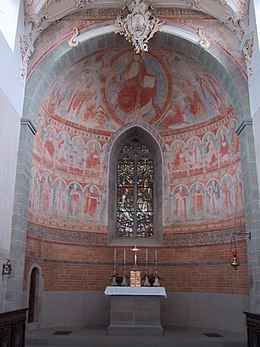Apse dome

The rounded, semi-dome-like arching of an apse is referred to as the apse dome ( French cul-de-four ) . Apse domes usually form the upper end of a semicircular apse - rectangular or square apses, on the other hand, are always barrel or rib vaulted or have a wooden flat ceiling or an open roof structure.
History and dissemination
Calottes were already found in the apsidially formed early Buddhist Chaitya halls of India ; They found their way into the architecture of medieval Europe via ancient basilicas and very probably also via thermal baths . With the adoption of the last-named building forms in church architecture of late antiquity and the early Middle Ages, apse domes were spread throughout the Christian world, where they were built into the 19th, and occasionally into the 20th century.
Statics
While elongated barrel , rib or cross vaults develop enormous vaulting that could even lead to their collapse, domed vaults are statically unproblematic - cracks only appear in rare cases.
Design
Many apse calottes have remained without decoration, but as early as late antiquity - especially in important buildings - the apse calottes were decorated with figural mosaics , later also with frescoes (usually with Pantocrator or Majestas Domini representations). In rarer cases they were given a supportive structure - perhaps based on the Indian models - with unprofiled ribs , and later with profiled vaulted ribs.
Apse calottes staggered in height in Hagia Sophia (around 535)
San Vitale in Ravenna
(around 545)Germigny-des-Prés
(around 805)Berzé-la-Ville (around 1100)
Apse calotte with unprofiled ribs in Santa María de Eunate (around 1180)
Apse calotte with ribs in San Salvador de Cantamuda (around 1200)
symbolism
While figures of saints were usually depicted in the lower part of an apse, the apse calotte is always provided with images of stars or figures from the heavenly world (mainly Christ as Pantocrator surrounded by the symbolic representations of the 4 evangelists ).
See also
- Tympanum field - the flat counterpart above the west portal to the deep apse calotte, which is mostly located in the east of a church
- Bezel - semicircular or circular segment-shaped framed wall fields (also called arch fields)
- Konche - semicircular niche with an apse-dome-like upper end
Non-Christian world
Also in parts of the Jewish and Islamic world - also outside of Ottoman architecture - there are comparable forms, often ribbed shell-like or with muqarnas decoration etc., but always without figurative picture decorations (→ iconophobia or ban on pictures in Islam ) to cover the Torah - or mihrab niches to be found.
Torah niche in the synagogue of Dura Europos (around 250)
Mihrab of the Rustem Pasha Mosque in Istanbul (16th century)










